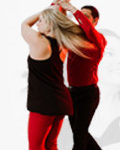If you have ever wondered why great dancers seem to pop against the backdrop while your dancing looks flat, this exercise is for you. West coast swing is a slotted dance, and so we emphasize keeping the dance within the linear slot to newer dancers. However, keeping the dance completely straight can make things look 2-dimensional. By dancing to the corners, you can add depth to your appearance while maintaining the slotted nature of the dance.
The Drill: In this drill, you are going to keep the slot oriented towards the walls as always. However, you will rotate your body so that you personally are facing the corner of the room. Which corner you face is up to you—generally it is easiest to open away from your connected hand, but dancing into your arm is perfectly acceptable too.
As you dance your basics with a partner, keep your body moving linearly on the slot as normal. The only thing that has changed is your orientation, not your line of dance. As you face different directions during patterns (e.g., during a whip), think about rotating past the wall to a new corner.
As you practice, you’ll discover parts of patterns that need to be oriented towards the wall in order to maintain the connection. That’s good, because shifting from corner-oriented to wall-oriented and back during the pattern both adds contrast and makes it clear that your orientation is a styling choice rather than a weird habit. As you incorporate the corners of the room into your dance, your dancing will look more three-dimensional and engaging.
[mediacredit inline=”FALSE”]




 Brian & Megan
Brian & Megan